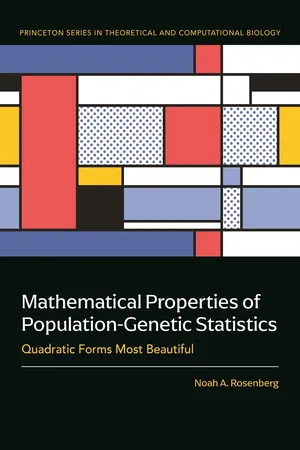
Mathematical Properties of Population-Genetic Statistics
Quadratic Forms Most Beautiful
- English
- ePUB (mobile friendly)
- Available on iOS & Android
Mathematical Properties of Population-Genetic Statistics
Quadratic Forms Most Beautiful
About this book
A powerful new approach to interpreting population-genetic data in evolution and ecology
Population genetics uses statistical analysis to catalog genetic variation among populations and species. Summary statistics computed from allele frequencies—mathematical functions that measure features of genetic similarity and diversity—are key to this global effort. Yet despite their widespread use in evolutionary biology, ecology, and conservation biology, their mathematical properties have largely been overlooked. This book shows how to use the mathematical bounds on summary statistics to make better interpretations of population-genetic data.
Noah Rosenberg discusses how the behavior of these statistics depends not only on the biology of the populations they seek to describe but also on the mathematical properties of the functions used to compute them, properties that produce constraints on the values of the statistics and influence their interpretation. Focusing on the concept of homozygosity—a quadratic function of allele frequencies in a population—he demonstrates how to account for mathematical constraints when measuring genetic similarity and diversity. Rosenberg illustrates the results using examples from empirical data and shares strategies that readers can use to apply this mathematical perspective to different kinds of summary statistics, including those for measuring biodiversity in ecological communities.
Drawing inspiration from Charles Darwin, who marveled at evolution’s “endless forms most beautiful and most wonderful,” this book presents a groundbreaking approach to the study of genetic variation. It is sure to stimulate new research in population biology and deeper thinking about the meaning and interpretation of essential measurements of the world’s genomes.
Frequently asked questions
- Essential is ideal for learners and professionals who enjoy exploring a wide range of subjects. Access the Essential Library with 800,000+ trusted titles and best-sellers across business, personal growth, and the humanities. Includes unlimited reading time and Standard Read Aloud voice.
- Complete: Perfect for advanced learners and researchers needing full, unrestricted access. Unlock 1.4M+ books across hundreds of subjects, including academic and specialized titles. The Complete Plan also includes advanced features like Premium Read Aloud and Research Assistant.
Please note we cannot support devices running on iOS 13 and Android 7 or earlier. Learn more about using the app.
Information
Table of contents
- Cover
- Princeton Series in Theoretical and Computational Biology
- Title Page
- Copyright
- Epigraph
- Contents
- Preface
- Acknowledgments
- 1. Mathematical and Biological Introduction
- 2. Homozygosity and the Most Frequent Allele
- 3. Variations on Homozygosity: JA, JB, and JC
- 4. The ith Most Frequent Allele
- 5. α-homozygosity
- 6. Estimated Homozygosity
- 7. Conclusions
- Notation
- Solutions to Exercises
- Bibliography
- Author Index
- Subject Index